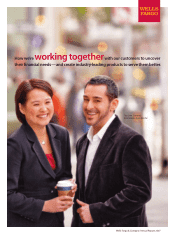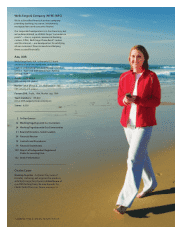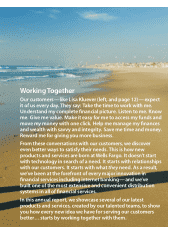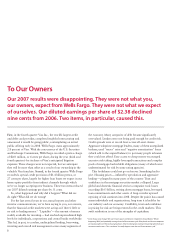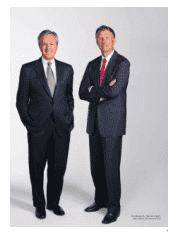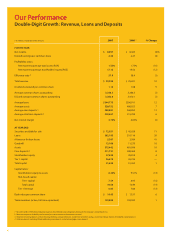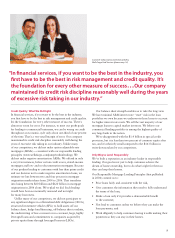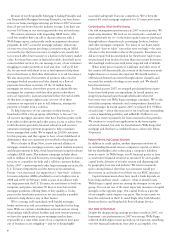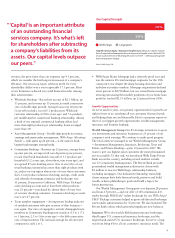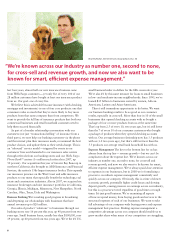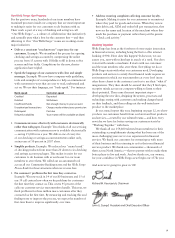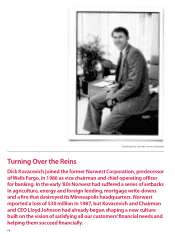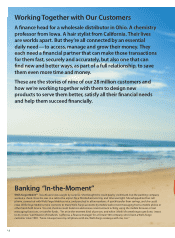Wells Fargo 2007 Annual Report Download - page 7
Download and view the complete annual report
Please find page 7 of the 2007 Wells Fargo annual report below. You can navigate through the pages in the report by either clicking on the pages listed below, or by using the keyword search tool below to find specific information within the annual report.
5
Credit Quality: What We Did Right
In financial services, if you want to be the best in the industry,
you first have to be the best in risk management and credit quality.
It’s the foundation for every other measure of success. There’s
almost no room for error. For instance, to meet our profit goals
for lending to commercial businesses, we can be wrong on credit
throughout an economic cycle only about one-third of one percent
of the time. That’s a very small margin of error. Our company
maintained its credit risk discipline reasonably well during the
years of excessive risk taking in our industry. Unlike many
of our competitors, we did not make option adjustable-rate
mortgages (ARMs) — consistent with our responsible lending
principles (www.wellsfargo.com/jump/truthinlending). We
did not make negative amortization ARMs. We offered in only
a very few instances, below certain credit scores, stated-income
mortgages and low- and no-documentation mortgages. Because
of our prudent lending to customers with less than prime credit
and our decision not to make negative amortization loans, we
estimate we lost between two and four percent in mortgage
origination market share from 2004 to 2006. That translates
into losing between $60 billion and $120 billion in mortgage
originations in 2006 alone. We’re glad we did. Such lending
would have been economically unsound and not right
for many borrowers.
Unlike many of our competitors, we did not participate to
any significant degree in collateralized debt obligations (CDOs),
structured investment vehicles (SIVs) to hold assets off our
balance sheet, hedge fund financing, off-balance sheet conduits,
the underwriting of low-covenant or no-covenant, large, highly
leveraged loans and commitments to companies acquired by
private equity firms through leveraged buyouts (LBOs).
Our balance sheet strength enables us to take the long view.
We have minimal ARM interest rate “reset” risk in the loan
portfolios we own because we underwrote those loans to account
for higher interest rate resets. We sell the vast majority of our
mortgage loans to capital market investors. We believe our
commercial lending portfolio is among the highest quality of
any large bank in the nation.
We’re disappointed with the $1.4 billion in special credit
provision, but it is less than two percent of common equity after
tax, and it’s relatively small compared to the $163 billion in
write-downs taken by our competitors.
Only Way to Lend: Responsibly
We’ve built a reputation as an industry leader in responsible
lending. Our goal is not just to help customers achieve the
dream of home ownership, but to do what’s right for them so
they can keep their homes.
Our Responsible Mortgage Lending Principles (first published
in 2004) commit us to:
• Price loans fairly and consistent with the risk,
• Give customers the information they need to fully understand
the terms of the loan,
• Make a loan only if it provides a demonstrable benefit
to the customer,
• Not lend to customers unless we believe they can make the
loan payments, and
• Work diligently to help customers having trouble making their
payments so they can stay in their homes.
“In financial services, if you want to be the best in the industry, you
first have to be the best in risk management and credit quality. It’s
the foundation for every other measure of success…Our company
maintained its credit risk discipline reasonably well during the years
of excessive risk taking in our industry.”
Customer Carlos Garcia and Vanessa Barba,
Wells Fargo Card Services (please see p. 14)

